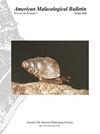近50年来唯一存活的哈氏小蠊种群的发现(腹足目:小蠊科)
IF 0.4
4区 生物学
Q4 MARINE & FRESHWATER BIOLOGY
引用次数: 0
摘要
摘要:夏威夷Pupoidopsis Pilsbry & C.M. Cooke, 1921,及其单种属是热带太平洋岛屿上瞳孔科的唯一代表。虽然该地区的大多数本地物种都是单岛特有的,但夏威夷伪种从夏威夷到土阿莫图斯都有记录。然而,自1965年以来就没有活的记录。在这里,我们报告了该物种在Anaa(土阿莫土群岛)单一地点的唯一现代生活种群。单个COI单倍型和单个28S等位基因支持自花受精假说。该物种应被列为极度濒危物种,并列入法属波利尼西亚保护物种名单。应该制定一项保护行动计划,将其最后一个已知的据点安纳列入保护名单。本文章由计算机程序翻译,如有差异,请以英文原文为准。
Discovery of the Only Living Population of Pupoidopsis hawaiensis (Gastropoda: Pupillidae) in the Last 50 Years
Abstract: Pupoidopsis hawaiensis Pilsbry & C.M. Cooke, 1921, and its monospecific genus, is the only representative of Pupillidae in tropical Pacific Islands. Although most of native species from that region are single island endemics, P. hawaiensis has been recorded from Hawaii to the Tuamotus. However, it has not been recorded alive since 1965. Here we report the only modern living population of that species from a single site in Anaa (Tuamotu archipelago). A single COI haplotype and a single 28S allele support the hypothesis of self-fertilization. The species should be listed as Critically Endangered, and included in the list of protected species of French Polynesia. An Action Plan for its conservation should be undertaken, with protection status given to its last known stronghold in Anaa.
求助全文
通过发布文献求助,成功后即可免费获取论文全文。
去求助
来源期刊
CiteScore
1.00
自引率
40.00%
发文量
1
审稿时长
>12 weeks
期刊介绍:
The American Malacological Bulletin serves as an outlet for reporting notable contributions in malacological research. Manuscripts concerning any aspect of original, unpublished research,important short reports, and detailed reviews dealing with molluscs will be considered for publication. Recent issues have included AMS symposia, independent papers, research notes,and book reviews. All published research articles in this journal have undergone rigorous peer review, based on initial editor screening and anonymous reviewing by independent expertreferees. AMS symposium papers have undergone peer review by symposium organizer, symposium participants, and independent referees.

 求助内容:
求助内容: 应助结果提醒方式:
应助结果提醒方式:


